The War on Greater Minnesota
This article originally appeared in the Summer 2019 issue of Thinking Minnesota, now the second largest magazine in Minnesota. To receive a free trial issue send your name and address to [email protected].
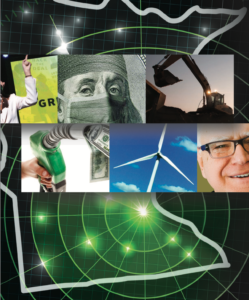 Picture Minnesota. Do you think of lakes, farm fields, and winding country roads, or busy city streets framed by the Minneapolis skyline? The answer depends a lot on which part of our diverse state you call home.
Picture Minnesota. Do you think of lakes, farm fields, and winding country roads, or busy city streets framed by the Minneapolis skyline? The answer depends a lot on which part of our diverse state you call home.
Most multigenerational Minnesotans can trace their roots back to ancestors who made their living on the land in small rural towns, either as farmers or miners. Now, more than half of Minnesotans live in the seven-county Twin Cities metro area, and many don’t have backyards to grow a garden, much less know anything about farming. In a practical sense, the urban-rural divide in Minnesota is very real.
If the prevailing attitude among Metro dwellers was “live and let live,” these differences wouldn’t matter. Unfortunately, it’s not.
In Minneapolis, every resident is forced to build his or her life around a justice agenda adopted by countless leftist institutions that run the city, starting with City Hall. Environmental justice demands bicycling or taking public transit everywhere you go. Economic justice demands redistributing wealth via government programs. Social justice demands feeling guilty about your privilege. Racial justice demands accommodating protests in the middle of the highway.
It doesn’t matter what you believe; the government will tell you how you’re allowed to live. If you don’t like it, move out.
Residents of Greater Minnesota are watching, warily. The justice brigade is coming for them, too.
For rural Minnesotans, it’s not just jobs or a small-town way of life at stake, it’s their very identity. Farm families take pride in the fact their relatives have cultivated the same land for generations, surviving and thriving through the good and bad years. Iron Rangers know their grandparents worked backbreaking 16-hour shifts in the iron mines during World War II to make sure America had enough steel to produce the tanks, battleships and rifles that allowed the Allies to win the war. Close-knit communities came together in times of hardship to weather the storm, rather than depending on aid from strangers.
These stories aren’t contrived or quaint; they have been passed down through generations and are a source of deep-seated pride for many. When urban liberals who know nothing about living in rural communities attempt to reshape people’s lives to fit their own vision of justice, it constitutes a decla-ration of war on Greater Minnesota’s very existence.
Green New Deal
It’s hard to think of a more straightforward assault on rural communities than freshman Congresswoman Alexandria Ocasio-Cortez’s Green New Deal. For the benefit of a slight reduction in greenhouse gas emissions, her proposal would cost Americans trillions of dollars, dramatically restructure the economy, and do away with some of the most important innovations of the past century. For starters, the Green New Deal proposes to eliminate all fossil fuel use by 2030, which means eliminating gas and diesel-powered cars and trucks. Even cattle are in the crosshairs, due to their methane emissions. 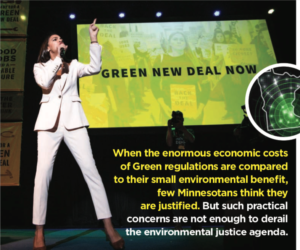
The impact of this policy on rural Minnesota is so absurd it’s laughable. The Green New Deal would impose outrageously high costs on energy-heavy industries concentrated in rural areas, destroy the agriculture industry, and make it virtually impossible to live anywhere that doesn’t have public transit options.
Despite this, urban liberals in the Twin Cities immediately embraced the Green New Deal hysteria and quickly tried to enact their own policies that promise to make life more difficult in Greater Minnesota. When the enormous economic costs of these regulations are compared to their immeasurably small environmental benefit, few Minnesotans think they are justified. But such practical concerns are not enough to derail the environmental justice agenda.
Health care for some
While the left claims to want affordable, easily accessible health care for all, the policies pushed by liberal politicians, like Obamacare, have resulted in the opposite. Now, new proposals threaten to further exacerbate the health care provider shortage, leaving rural Minnesotans without local access to doctors or hospitals.
A recent analysis by consulting firm Navigant found one in five rural hospitals in Minnesota is in high financial distress and in danger of closing. Most of those hospitals are considered “essential” to their communities because of a shortage of beds or trauma care in the region. 
Tellingly, the report cites “under-compensated care” by government programs like Medicare and Medicaid as a main contributor to rural hospitals’ financial distress. The ONECare plan proposed by Governor Walz works exactly this way. Rather than reducing the cost of health care, ONECare would simply pay hospitals less. The consequences of passing it would be devastating to Minnesotans who would lose access to care within a reasonable driving distance.
Even when hospitals don’t close, they stop offering important services that then leave rural Minnesotans stranded without basic care. In recent years, for example, several rural hospitals have stopped providing labor and delivery services. In 2000, 15 counties in Minnesota had no in-hospital obstetrics care. In 2015, that number had nearly doubled, to 28.
Mining
Mining contributes $2.4 billion to the state’s economy, but it could be $5.9 billion more. New mineral resource data show non-ferrous mining could create a total of 14,851 new jobs. Adding the 5,300 people who currently work in taconite, Minnesota’s mining industry has the potential to employ 20,000 Minnesotans and contribute $8.3 billion to the state’s GDP every year.
However, the mining industry is under constant attack by environmental activists who file endless lawsuits and pressure lawmakers to propose strict renewable energy mandates. Abiding by these energy mandates would cost existing mines and paper mills hundreds of millions of dollars per year and impair the economic viability of future mining projects in Minnesota. The Iron Range, which produces just two percent of global iron, faces an even tougher challenge to stay competitive in the global marketplace.
Environmental groups—whose headquarters are almost always located in Minneapolis and St. Paul—argue that people living on the Iron Range should get low-paying jobs in the tourism industry instead of supporting more mining by responsibly developing Minnesota’s vast copper, nickel, titanium, cobalt, and iron reserves. It is hard to think of a sentiment that could be more insulting to Iron Range residents. Mining isn’t just a high-paying job; it is part of Minnesota’s heritage. America needed the Range in WWII, and the Range delivered. The Range would like to deliver a whole lot more.
It’s telling that Congresswoman Betty McCollum of St. Paul is perhaps the most outspoken critic of copper-nickel mining in the state, and Congressman Pete Stauber, who represents northeastern Minnesota, is one of the industry’s big-gest champions.
Transportation
The 70 percent gas tax increase championed by Governor Walz and the House DFL Majority this year wasn’t just about raising additional funds to fix the roads. If it was, the proposal wouldn’t have included a budgeting gimmick that diverted existing road funding toward other programs. 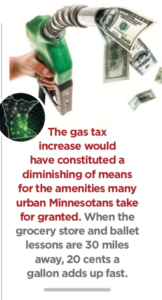
The purpose of the gas tax increase was twofold: to raise additional revenue from the gas tax so general fund money could be diverted elsewhere, and to make driving more expensive, thus incentivizing alternatives to gas-powered cars and reducing emissions.
If this idea seems far-fetched, consider that reducing emissions was the exact justification used by French President Emmanuel Macron when he proposed a tax increase on diesel fuel. The historic unpopularity of this gas tax increase resulted in hundreds of thousands of French residents rioting in the streets.
In France, it was rural residents who rose up against the gas tax, not the urban population in Paris. Likewise, a gas tax increase might not have bothered people living in Minneapolis or St. Paul, but it would have disproportionately harmed people living in Greater Minnesota because they generally have farther to drive than residents of the Twin Cities.
Using the Center’s “No New Gas Taxes” web page, Laurie T. of Warroad sent an email to Governor Walz that makes this point: “I don’t believe that you have Greater Minnesota’s best interest in mind. Where I live, six miles from the Canadian border, we do not have buses or light rails. We have cars and trucks that get us to our jobs that can be anywhere from one to 90 miles travel—one way. How will the people YOU represent be able to afford fuel to get to work, food and clothing for their families, and child care?”
While the gas tax increase, by itself, may not have been an existential crisis to most rural Minnesotans’ family budgets, it certainly would have constituted a diminishing of means for the amenities many in the metro take for granted. When the grocery store and ballet lessons are 30 miles away, 20 cents a gallon adds up fast. If the Walz administration had sincerely attempted to fund the roads with a modest increase, and didn’t try to divert existing road money toward other expenditures, it might have been able to pass a gas tax increase. But knowing that revenue from higher gas taxes would go toward subsidizing $2,500 rebates for wealthy urbanites to buy electric cars doesn’t instill much confidence in the other half of the state.
Under my (green) thumb: Micromanaging agriculture
Leftist environmentalists have little, if any, idea how life works on a farm, or how food makes it from the fields to their table. However, this hasn’t stopped them from imposing burdensome mandates on farmers (such as buffer strips and ditch mowing rules) or viewing the carbon footprint of agriculture as a problem they must solve. 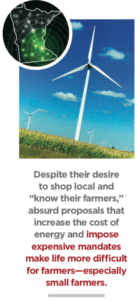
The Star Tribune chose to feature an op-ed that correctly identified farming as an energy intensive industry but went on to propose subsidizing electric tractors. Such a proposal is completely out of touch with the reality of life on the farm. Only an urbanite could see this as a viable idea.
For instance, the John Deere electric tractor referenced in the Star Tribune op-ed costs $634,000 and can run for up to four hours before it must be recharged for three. In contrast, a nearly new Case IH Magnum tractor retails for $264,000 and can run for up to eight hours before it must take 15 minutes to refuel.
Even if cost were not an issue, the four-hour battery life would be. It is not unusual for farmers to spend 12 to 16 hours per day behind the wheel during planting season to prepare fields, plant crops, apply fertilizer, etc. There simply isn’t time to wait three hours for recharging, especially if there is a late or exceptionally wet spring (like this year), when planting is significantly behind schedule. Despite their desire to shop local and supposedly “know their farmers,” absurd proposals by urban liberals actively make life more difficult for farmers—especially small farmers—to stay in business and keep food on our tables.
Do as I say, not as I do
The next time you drive through southern Minnesota, take note of the wind farms. Then try to think of the last time you saw a wind turbine in the Twin Cities metro area. It’s difficult, because none exist within the inner circle of I-494/I-694. There are only seven wind turbines in the entire seven-county metro, compared to more than 2,500 spread across the rest of the state.
Twin Cities liberals feel righteous because some of their electricity is produced—however needlessly and inefficiently—by wind turbines. But it is residents of Greater Minnesota who have to live with the daily presence of ugly, vibrating, bird-killing, 50-story-high turbines. And all Minnesotans foot the bill for hundreds of millions of dollars in transmission lines to carry the electricity from Greater Minnesota to where it is consumed, in the Twin Cities.
The same concept applies to public transit. Construction is about to begin on the new light rail project that will cut through the Minneapolis Chain of Lakes, and the first step is to cut down beautiful, established trees on the popular Kenilworth Trail. Wealthy elites who live near the train’s path, and support it in concept, have fought against its construction because they don’t want their own landscape disfigured. They ignore the fact that their policies have forced residents of Greater Minnesota to live with a disfigured landscape.
CoeXis†?
Tim Walz shrewdly ran his campaign for governor under a banner of unity; a hopeful message focused on finding common ground. His “OneMinnesota” campaign slogan was nice, but it lacks substance. 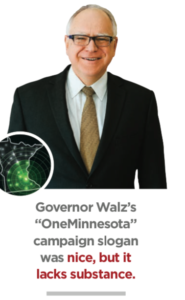
Leftist politicians who represent the metro area continue to push for policies that fulfill their agenda-driven dreams but have tremendous real-world costs for Greater Minnesota. In their arrogance, they feel justified in telling everyone else how they should live.
This attitude is incredibly insulting. The people of Greater Minnesota do not live and work at the pleasure of people who live in more densely-populated areas. They do not exist to scoop ice cream on the weekends for people who live in Minneapolis. They are proud people, good people, who are tired of being portrayed as backward, bigoted, or unenlightened.
Greater Minnesotans don’t need any more lip service from politicians and urban elites who nod and pretend to understand their way of life but express contempt for it through their actions. It will take more than platitudes to repair the decades of mistrust.
Maybe there is an honest lack of under-standing between rural and metro Minnesota, and we just need to get to know each other better. That’s the optimistic take. The more cynical view is that we understand each other fine; some people just don’t like what they see, preferring to view their rural neighbors as “deplorables” and “bitter clingers.” Not too long ago, Governor Walz dismissed rural Minnesota as “mostly rocks and cows.”
At this point, residents of Greater Minnesota just want to be left alone. Can’t we all just CoeXis†?
Isaac Orr is a policy fellow at Center of the American Experiment, where he writes about energy and environmental issues, including mining and electricity policy.